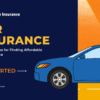Auto insurance is a crucial financial tool that helps protect both drivers and vehicles from unforeseen accidents, damages, and liabilities. Understanding the different types of coverage is essential for making informed decisions and ensuring adequate protection on the road. This guide explores the key components of auto insurance coverage, what they mean, and how they can benefit you.
Disclaimer: Not all applicants will qualify for the lowest monthly payments. $30/month for minimum coverage and clean driving history. Nerd Wallet Insurance Services, Inc. (CA resident license no. OK92033)
1. Liability Coverage
Liability insurance is typically mandated by law and covers expenses related to injuries or damage you cause to others in an accident. It has two main components:
- Bodily Injury Liability: Covers medical expenses, lost wages, and legal fees for injuries you cause to another person in an accident.
- Property Damage Liability: Pays for the repair or replacement of property (such as other vehicles or buildings) damaged in an accident you are responsible for.
Having sufficient liability coverage ensures that you are protected from significant financial loss in the event of a major accident.
2. Collision Coverage
Collision insurance pays for the cost of repairing or replacing your vehicle after a collision, regardless of who is at fault. This type of coverage is particularly valuable if you have a newer or more expensive vehicle. It covers damages resulting from accidents with other vehicles or objects (e.g., fences, trees, or guardrails).
While collision coverage is optional, it may be required by lenders if your car is financed or leased.
3. Comprehensive Coverage
Comprehensive insurance covers damages to your car that are not caused by collisions. This includes events like theft, vandalism, fire, natural disasters, or hitting an animal. Comprehensive coverage ensures that you’re protected from non-accident-related incidents that could result in costly repairs or a complete loss of the vehicle.
Like collision insurance, comprehensive coverage is optional but may be required by a lender.
4. Uninsured/Underinsured Motorist Coverage
Uninsured motorist (UM) and underinsured motorist (UIM) coverage protect you in cases where you are involved in an accident with a driver who has no insurance or insufficient insurance. This coverage pays for your medical bills, lost wages, and other related expenses if the at-fault driver cannot cover the damages.
UM and UIM coverage can provide peace of mind in hit-and-run scenarios or when dealing with financially irresponsible drivers.
5. Personal Injury Protection (PIP)
Personal injury protection (PIP), also known as “no-fault insurance,” covers medical expenses for you and your passengers, regardless of who is at fault in the accident. In some states, PIP also covers lost wages and other expenses related to your injury, such as rehabilitation costs and essential services (e.g., child care).
PIP is often required in states with no-fault insurance laws, but even in states where it’s optional, it can be a valuable addition to your coverage.
6. Medical Payments Coverage (MedPay)
Medical payments coverage, or MedPay, is similar to PIP in that it covers medical expenses after an accident, regardless of fault. However, it generally has more limited benefits than PIP, focusing solely on medical costs. MedPay is a good supplement if your health insurance plan has high deductibles or limited coverage for auto-related injuries.
7. Gap Insurance
Gap insurance is particularly important for those who have financed or leased their vehicles. If your car is totaled or stolen, gap insurance covers the difference between the actual cash value of the vehicle (what your insurance pays) and the amount you still owe on the loan or lease. This prevents you from having to pay out of pocket for a vehicle you no longer have.
Conclusion
Understanding the various components of auto insurance coverage is critical to ensuring you have the right protection for your needs. While liability coverage is typically mandatory, other types of coverage, such as collision, comprehensive, and uninsured motorist insurance, provide additional protection that can save you from financial distress in the event of an accident. By evaluating your personal situation, vehicle value, and state requirements, you can create a well-rounded policy that offers peace of mind on the road. Comparing car insurance quotes on a site like NerdWallet can help you find a rate that fits your budget
















